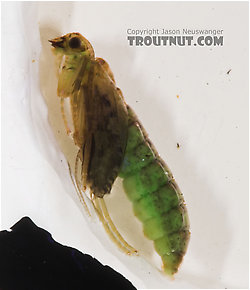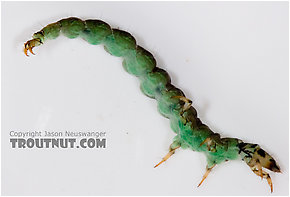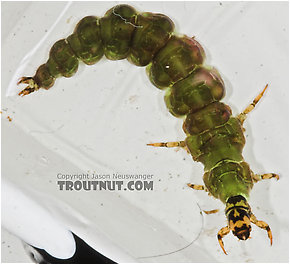Blog & Latest Updates
Fly Fishing Articles
Insects by Common Name


Caddisfly Genus Rhyacophila (Green Sedges)
Taxonomic Navigation -?-
Kingdom
Animalia (Animals)
» Phylum
Arthropoda (Arthropods)
» Class
Insecta (Insects)
» Order
Trichoptera (Caddisflies)
» Family
Rhyacophilidae (Green Sedges)
» Genus Rhyacophila (Green Sedges)
119 species aren't included.
Common Names
| Match | Common Name |
| Green Sedges | |
| Green Rockworms | |
| Brown and Green Caddisflies |
Hatching Behavior
Habitat: Riffles
The pupae swim quickly up through the riffles and emerge on the surface.Egg-Laying Behavior
Habitat: Riffles
The females dive or crawl underwater to oviposit. When they're done they let go and dead-drift (Dead-drift: The manner in which a fly drifts on the water when not moving by itself or by the influence of a line. Trout often prefer dead-drifting prey and imitating the dead-drift in tricky currents is a major challenge of fly fishing.), floating slowly to the surface.Larva & Pupa Biology
Diet: For most species, other aquatic insects.
Current Speed: Fast
Environmental Tolerance: Most species require cool water
Shelter Type: No case
Rhyacophila larvae are large, usually green, and always plump, and they don't build cases or nets. They roam freely about the fast water and they often drift loose, where they are a good food for trout.Current Speed: Fast
Environmental Tolerance: Most species require cool water
Shelter Type: No case
Many of these larvae have no gills at all and rely on absorbing oxygen from the water through their skin. Only cold water and fast flows can meet these needs, so Rhyacophila caddisflies love the same habitat as trout.
The larvae may rappel between the rocks on a line of brown silk they secrete. This can be imitated by coloring the last foot or so of one's leader with a brown marker.
Rhyacophila Fly Fishing Tips
Gary LaFontaine wrote some good tips in Caddisflies about fishing appropriate flies for the water you're covering:
A good imitaiton of a Rhyacophila larva is going to catch a lot of trout in swift, bouncing stretches of stream. The same fly is going to do poorly in slow areas of the same stream.
A fly fisherman can avoid wasting time in the wrong sections of a stream by working leap-frog fashion instead of in a straight line. If he is using an imitaiton of a fast-water insect he should fish only the swift, broken currents, skipping past the slower current areas. Likewise, if he is using an imitation of a slow-water insect he should only cover the quieter pools and flats.
He was speaking about fishing Rhyacophila imitations, but the advice is equally applicable to many aquatic insects. He cautions against using these imitations where the real insects are not abundant in the drift, because they are otherwise too large and bright to seem realistic.
Pictures of 13 Caddisfly Specimens in the Genus Rhyacophila:
Rhyacophila (Green Sedges) Caddisfly Pupa View 11 PicturesI collected this pupa and several like it from the same stream and on the same day as this larva. I suspect they're the same species. Every pupa I collected was in a brown casing like the one shown in one of the pictures below. I cut this pupa out of its case after a picture so you can see more details. It is close to but not fully developed.
View 11 PicturesI collected this pupa and several like it from the same stream and on the same day as this larva. I suspect they're the same species. Every pupa I collected was in a brown casing like the one shown in one of the pictures below. I cut this pupa out of its case after a picture so you can see more details. It is close to but not fully developed.
 View 11 PicturesI collected this pupa and several like it from the same stream and on the same day as this larva. I suspect they're the same species. Every pupa I collected was in a brown casing like the one shown in one of the pictures below. I cut this pupa out of its case after a picture so you can see more details. It is close to but not fully developed.
View 11 PicturesI collected this pupa and several like it from the same stream and on the same day as this larva. I suspect they're the same species. Every pupa I collected was in a brown casing like the one shown in one of the pictures below. I cut this pupa out of its case after a picture so you can see more details. It is close to but not fully developed.Collected June 5, 2005 from the Long Lake Branch of the White River in Wisconsin
Added to Troutnut.com by Troutnut on May 25, 2006
Added to Troutnut.com by Troutnut on May 25, 2006
Rhyacophila fuscula (Green Sedge) Caddisfly Larva View 11 Pictures
View 11 Pictures
 View 11 Pictures
View 11 PicturesCollected April 1, 2007 from Mystery Creek #62 in New York
Added to Troutnut.com by Troutnut on April 3, 2007
Added to Troutnut.com by Troutnut on April 3, 2007
Rhyacophila fuscula (Green Sedge) Caddisfly Larva View 11 PicturesI collected this larva and several like it from the same stream and on the same day as this pupa. I suspect they're the same species.
View 11 PicturesI collected this larva and several like it from the same stream and on the same day as this pupa. I suspect they're the same species.
 View 11 PicturesI collected this larva and several like it from the same stream and on the same day as this pupa. I suspect they're the same species.
View 11 PicturesI collected this larva and several like it from the same stream and on the same day as this pupa. I suspect they're the same species.Collected June 5, 2005 from the Long Lake Branch of the White River in Wisconsin
Added to Troutnut.com by Troutnut on May 25, 2006
Added to Troutnut.com by Troutnut on May 25, 2006
Your Thoughts On Rhyacophila:
Top 10 Fly Hatches
Top Gift Shop Designs
Eat mayflies.
Top Insect Specimens
Miscellaneous Sites
Troutnut.com is copyright © 2004-2024 Jason
Neuswanger (email Jason). See my FAQ for information about use of my images.
 privacy policy
privacy policy
